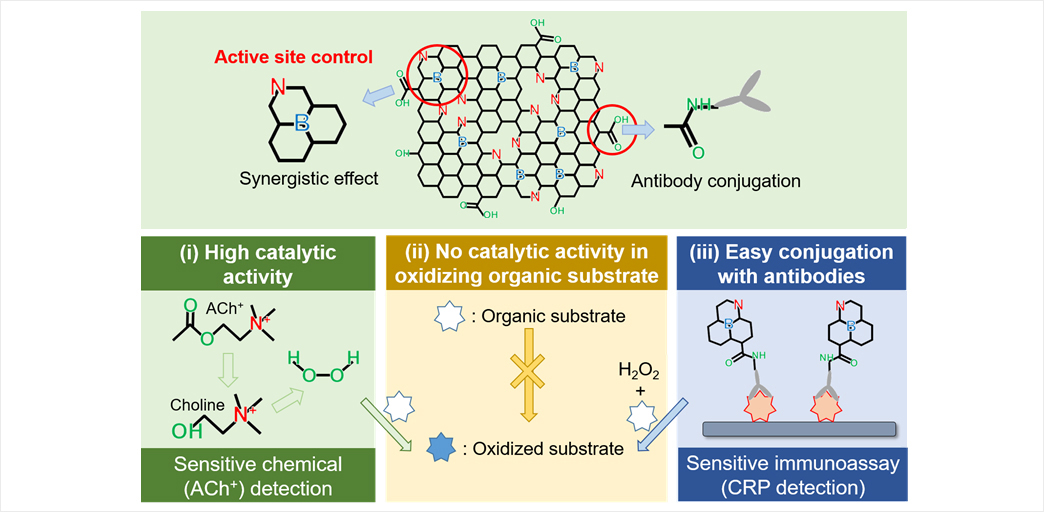with selectivity and its application for detection of acetylcholine
Prof. Jinwoo Lee's group presented a new carbon-based nanozyme with superior catalytic activity with selectivity. Nitrogen and Boron co-doped graphene (NB-rGO), the new carbon-based nanozyme, was also investigated with computational chemistry and employed for colorimetric detection of acetylcholine, which is known to be related to the Alzheimer's disease.
The research group doped nitrogen and boron into the graphene, which is carbon-based material with low price, to selectively increase the peroxidase-like activity and succeeded to synthesize a peroxidase-mimicking nanozyme with low price and superior catalytic activity. The prepared nitrogen and boron co-doped graphene was applied to bioassay of detecting acetylcholine which is related to Alzheimer's disease and successfully detected the acetylcholine compared to nature enzyme.
Enzymes are the main catalysts in our body and widely used in bioassays. Especially, peroxidase, which oxidizes transparent colorimetric substrate to become a colored product in the presence of hydrogen peroxide, are most common enzymes that are used in colorimetric bioassays that could detect not only hydrogen peroxide but also the various materials which generate hydrogen peroxide in the oxidation process. However, natural enzymes, which are composed of protein, are unstable toward temperature and pH, hard to synthesize, and expensive. Nanozymes, which are not composed of protein, could overcome the disadvantages of the enzyme with its robustness and high productivity. In contrast to the advantages, most nanozymes don't have selectivity. For example, peroxidase-mimicking nanozymes also have oxidase-like activity that oxidizes colorimetric substrates in the absence of hydrogen peroxide, which hinders the precise detection of the target materials including hydrogen peroxide.
The research group achieved to synthesize the peroxidase-mimicking nanozyme with superior catalytic activity and selectivity toward hydrogen peroxide. Co-doping of nitrogen and boron into graphene, which has negligible peroxidase-like activity, selectively increased the peroxidase-like activity without oxidase-like activity to accurately mimic the nature peroxidase and become a powerful candidate replacing the peroxidase. In addition, the experimental results were convinced with computational chemistry. The nitrogen and boron co-doped graphene was also applied to colorimetric detection of acetylcholine, important neurotransmitter and successfully detected the acetylcholine even better than the nature peroxidase.

Professor Lee said, "Though nanozyme has not been studied for a long time, it is actively studied due to the potential to be used in place of existing enzymes" and also added "Through this study, we have secured technologies to synthesize the nanozymes that have high enzyme activity with selectivity and the resulting nanozyme could be applied to effectively detect acetylcholine, which is related to Alzheimer's disease." This research was led by Dr. Min Su Kim and graduate student Junsnag Lee and an article entitled "N- and B-Codoped Graphene: A Strong Candidate To Replace Natural Peroxidase in Sensitive and Selective Bioassays" was published in ACS Nano.
Link: https://pubs.acs.org/doi/10.1021/acsnano.8b09519




